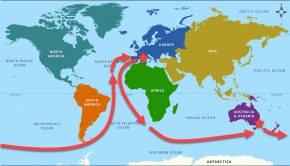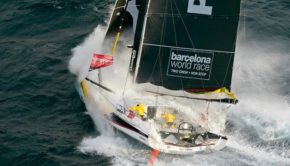Final podium position filled at Barcelona World Race
Published on April 1st, 2015
(April 1, 2015; Day 92) – Catalan co-skippers Anna Corbella and Gerard Marin set out on 31st December 2014 at the start of the third edition of the Barcelona World Race with a defined game plan. If it worked out for them a podium place was their objective. Today they delivered.
Fundamental to their strategy was racing at a pace that would give them their best chance of finishing, to push hard when they could but to preserve themselves and their boat above all else. Finishing and sailing a smart, intelligent race to the best of their abilities was their goal.
As the first team to enter this third edition of the race, signing up in 2012, the duo have had the most clearly defined, focused training time of all the teams in this race. They have been equipped with a well proven, well optimised IMOCA 60 of the same generation and design as the first and second placed boats in this race, Cheminées Poujoulat and Neutrogena, a 2007 Farr design which also took third place in the last edition of the race.
Their project, like them, is an all Catalan affair, and today they have realised the podium finish that they considered was within their reach – if they stuck to their strategy, day in day out, around the world.
Corbella and Marín have been fourth, then third almost all the way around the course. In the depths of the south Pacific ocean they got to within eight miles of Neutrogena, Guillermo Altadill and José Munoz, who went on to take second. They finish 1d 17h 22m 28s behind second placed Neutrogena.
Corbella and Marin’s third place is 6 days 23hours 19 min 03 sec after race winners, Bernard Stamm and Jean Le Cam who finished last Wednesday 25th March at 17:50:25hrs UTC. The Catalan duo finished the course non stop.
The actual distance Marin and Corbella sailed is 28,127.16 nm at an average of 12.85kts
Shining Spanish stars who are still rising.
The Catalan duo mark a big leap up in their abilities since the last edition of the race. Back then, the former Mini class racers were very much on the nursery slopes of the IMOCA 60 race round the world, both individually mentored by more experienced skippers. Dee Caffari raced with Corbella in the last edition on Caffari’s former Aviva on which she finished sixth in the Vendée Globe, while Marín – the youngest co-skipper in 2010-11 – raced alongside Frenchman Ludovic Agalor on Forum Maritim Català and finished eighth.
Partnered up by the FNOB, their training together included the Transat AG2R in the Figaro class and last year’s New York to Barcelona Race during which they really highlighted their progress and potential. Finishing third, they were pushing a lot of the more experienced teams hard, proving they were confident in taking their own decisions and followi ng their own strategy, just as they have several times in this Barcelona World Race. This time they proved they can not only match the pace of the faster duos, but can keep their boat together and competitive.
Corbella, a qualified vet and Marín, a past Europe dinghy class world champion who left behind a three month old daughter to do the race, lost some small miles in the North Atlantic when they had to drop their mainsail to repair it and replace three broken battens and did not manage to stay with their two nearest rivals on the entrance to the Indian Ocean and became snared for two or three days in a zone of light airs when the Roaring Forties only whispered for them.
The race’s only mixed sex duo were unlucky to be trapped in another cell of calm airs in the Southern Ocean and ended up bouncing slowly along the Antarctic Exclusion Zone, but they proved themselves to have enormous stamina and a quietly stated but voracious appetite for the race. They worked consistently and with discipline to keep their boat at close to 100 per cent, sometimes rewarding themselves with treats for getting their jobs list back to zero! On January 8th they lead the race albeit briefly, and again got up to second momentarily in the Pacific. Corbella sustained a knee ligament injury north of the Canaries when she was thrown across the boat, and Marin sailed many of the final miles in solo mode for much of the time.
The Boat
Their boat started life as Gitana Eighty of Loick Peyron, a leader during the 2008-9 Vendée Globe. It finished third around the world in the 2010-11 as Renault ZE in the hands of Spaniards Pachi Rivero and Toño Piris and sailed to fifth place in the last Vendée Globe as SynerCiel with new Barcelona World Race champion co-skipper Jean Le Cam.
After the technical stop of Neutrogena in New Zealand, Corbella and Marin saw the chance to catch up and tantalisingly came to be less than ten miles behind Altadill and Munoz. After rounding Cape Horn at just ten hours behind Altadill and Munoz, their Atlantic climb finally saw Neutrogena move progressively further ahead, but their highly commendable third place is a worthy reflection of their further potential, a team which has proven solid and, surely, stronger together than the sum of its parts.
The fourth-placed finisher is expected around April 9. The fight for this position remains open between the One Planet, One Ocean & Pharmaton and We Are Water which are racing towards the Strait of Gibraltar with some 127 miles of difference between them.
Ranking at 18:00 UTC:
1. Cheminées Poujoulat (Bernard Stamm – Jean Le Cam) finished Mar 25 (84:05:50:25)
2. Neutrogena (Guillermo Altadill – Jose Muñoz) finished Mar 31 (89:11:47:00)
3. GAES Centros Auditivos (Anna Corbella – Gerard Marin) finished Apr 1 (91:05:09:28)
4. One Planet One Ocean / Pharmaton (Aleix Gelabert – Didac Costa) 1247.6 nm Distance to Finish
5. We Are Water (Bruno Garcia – Willy Garcia) 1377.9 nm DTF
6. Renault Captur (Jörg Riechers – Sebastien Audigane) 2664.3 nm DTF
7. Spirit of Hungary (Nandor Fa – Conrad Colman) 3195.8 nm DTF
Hugo Boss (Alex Thomson – Pepe Ribes) Abandon
Report by event media.
Background: The third edition of the Barcelona World Race is the only double-handed, non-stop, round the world race. Eight IMOCA 60 teams started December 31, 2014, with the intent to cover 23,450 nautical miles in a circumnavigation from Barcelona to Barcelona, putting the capes of Good Hope (South Africa), Leeuwin (Australia) and Horn (Chile) to port and the Antarctic to starboard.









 We’ll keep your information safe.
We’ll keep your information safe.